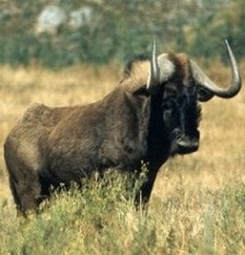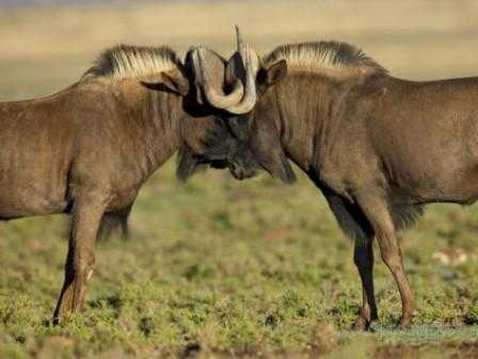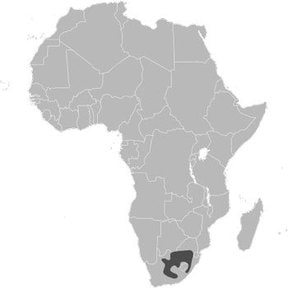Black WildebeestConnochaetes gnou |

Custom Search
|
|
The Black wildebeest (Connochaetes gnou) also known as White-tailed gnu, is an ungulate that lives in the savannas of central and eastern South Africa. The species historic range also included the open plains and grasslands of Lesotho and Swaziland.
However, indiscriminate hunting for their hides and habitat destruction for agriculture during the 19th century reduced their numbers in the wild quite considerably. Nowadays these African antelopes are found only on protected game farms in southern Africa. In the past black wildebeest inhabited the highveld temperate grasslands during the dry winter and in the rainy season they migrate to the arid to semiarid Karoo regions. But even when in the past their numbers were much higher on the central plains of South Africa they never migrated en masse as their close relative the Blue Wildebeest still does in places. They are very gregarious animals, forming groups consisting of males and females with calves (30 to 500 individuals, usually), but are also seen groups composed solely of females and their offspring or by single males. In periods of drought, animals of various groups gather in herds which can reach thousands of individuals.These herds migrate towards the major rivers and lakes across considerable distances. The wildebeests are often associated with other African ungulates such as impala, giraffes, and zebras in particular. They may also be associated with the ostriches.
They have a dark brown coat, almost black in some older males. On the muzzle, and under the neck, they have a dense row of black hairs. They exhibit a long bristly mane cream to white in color with black tips that extends from the neck to the back.
Males measure up to 121 cm at the shoulder and weigh up to 161 kgs (355 lbs) with a body length of 2 meters (6.6 ft). While females are slightly smaller reaching about 1.16 m height at the shoulder and weigh 130 Kg. The head is large, the neck is short and the legs are relatively long. Horns fold forward in an arc and they are also too bent up measuring up to 78 cm in males, and 45 to 60 cm in females. The shoulders are much higher than the croup. The tail is white, giving it its common name, White-tailed gnu. They have scent glands located under hair tufts in front of their eyes and on their forefeet. The Black wildebeest is an extremely fast runner, reaching a maximum speed being of 50 mph (80 km/h). They serve as an important prey base for large predators such as lions, hyenas, leopards, cheetahs, cape hunting dogs and the Nile crocodile. More so during the calving seasons. The typical lifespan of the black wildebeest in the wild is about 20 years. Subspecies / Etymology / Taxonomy There are no subspecies currently recognized. The Black Wildebeest was first described in 1780 by Eberhard August Wilhelm von Zimmermann a German zoologist and geographer. The word "Gnu" derives from a Khoikhoi word “ge-nu”, referring to their typical snort. Diet / Feeding The Black wildebeest is primarily a grazer just like their close relative the Blue wildebeest (Connochaetes taurinus) feeding mainly on short grasses. Occasionally it will also eat shrubs and herbs especially when grass becomes scarce. While shrubs can comprise as much as a third of their diet, normally grasses comprise more than 90% of their diet. When grazing the herd moves in loose groups or in line, while when moving about they usually walk in single file. Even though they can go without drinking everyday water is essential to their survival. In the past prior to the arrival of Europeans these wildebeest used to roam widely probably according to the rains and the availability of good foraging sites. Reproduction
Males are usually solitary or live in small bachelor groups with other males. Only males with an established territory can mate and will attempt to herd females into their territory. These males fight each other to form their harems, with territorial displays consisting mostly of ritualized combats, with more severe fights being quite rare. Females are normally more aggressive than males, living in small herds with their young.The gestation period is nine to ten months, after which a calf is born, and very soon after birth, the calf is capable of standing up and follow the herd. They are possibly the most precocious of all hoofed mammal species. During the mating season, which varies with geographic location, but births have their peak from November to December or January, just after the first rains. With most births occurring within a 2 or 3 week period. The calve is breastfed until the age of nine months (possibly until the first years of age). Females reach sexual maturity at two to three years of age and males from the age of three or four. But only four years and older males are able to get a territory and mate. The Black wildebeest frequently hybridizes with its close relative the Blue Wildebeest when found in the same area. Usually, the interspecies offspring is fertile but many of them display abnormalities in their teeth, skull, and horns. Conservation status and major threats It is a species considered at low risk but conservation dependent (according to the International Union for Conservation of Nature). It existed in the past thousands of individuals in South Africa, but hunting and habitat destruction due to agricultural expansion led the Black Wildebeest almost to extinction. Reintroduction programs were conducted, and currently exists in protected areas in South Africa, the species reproduces well in zoos.
|
Scientific classification
Kingdom: Animalia Phylum: Chordata Class: Mammalia Order: Artiodactyla Family: Bovidae Subfamily: Alcelaphinae Genus: Connochaetes Species: C. gnou |



